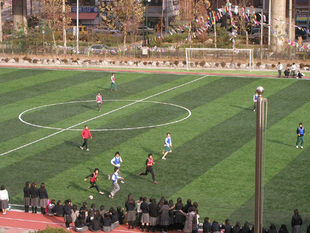hankyoreh
Links to other country sites 다른 나라 사이트 링크
Artificial turf causing skin disease at nation’s schools

Students and teachers in schools with grounds covered by artificial turf are suffering from headaches and skin disease in a growing number of cases.
Choi Yeong-gil, a teacher at a Seoul elementary school, said on July 1, ‘‘Since the school laid synthetic turf on the ground in May, I have taught the students with the doors of the classrooms closed even in the summer, due to the offensive smell. The school infirmary is filled with students complaining about skin disorders and headaches.’’
Park Yeong-gil, a physical education teacher at another elementary school, mentioned, ‘‘After teaching classes on the turf for four hours a day, I feel pain in my nose and eyes and have also contracted atopic dermatitis.’’
Today, the Ministry of Education & Human Resources Development launches an investigation into the artificial turf which began to be installed at many of the nation’s schools in 2000. The ministry wants to know more about the relationship between artificial turf and the diseases suffered by teachers and students.
The ministry recently sent official documents to 170 schools with synthetic turf on their grounds and requested that the Korea Testing & Research Institute and the Korea Environment & Merchandise Testing Institute investigate the realities of the situation.
Jeong Sang-ik, a ministry official, said, ‘‘The investigations are aimed at grasping the safety of the poisonous materials such as lead, cadmium and mercury contained in the artificial turf. We also want to confirm just how harmful these materials, which have sparked controversy in our schools, are.’’
The investigations will be conducted according to standards set up last year by the Korean Agency for Technology and Standards, which operates under the Ministry of Commerce, Industry and Energy. Korea Testing & Research Institute and the Korea Environment & Merchandise Testing Institute will extract about 100 grams of rubber power from each school’s artificial turf for the investigation. The legal limits for harmful materials contained in rubber powder are 90 milligrams of lead, 5 milligrams of cadmium and 25 milligrams of mercury and chrome per one kilogram of powder. Benzene is classified as ‘‘harmful’’ if it exceeds 1 milligram.
As of now, 605 elementary, middle and high schools across the nation have artificial turf on their grounds and the Ministry of Education, in cooperation with the Seoul Olympic Sports Promotion Foundation, currently has plans to install artificial turf at 443 more schools until 2010.
Please direct questions or comments to [englishhani@hani.co.kr]
Editorial・opinion
![[Guest essay] The real reason Korea’s new right wants to dub Rhee a founding father [Guest essay] The real reason Korea’s new right wants to dub Rhee a founding father](https://flexible.img.hani.co.kr/flexible/normal/500/300/imgdb/original/2024/0423/8317138574257878.jpg) [Guest essay] The real reason Korea’s new right wants to dub Rhee a founding father
[Guest essay] The real reason Korea’s new right wants to dub Rhee a founding father![[Column] ‘Choson’: Is it time we start referring to N. Korea in its own terms? [Column] ‘Choson’: Is it time we start referring to N. Korea in its own terms?](https://flexible.img.hani.co.kr/flexible/normal/500/300/imgdb/original/2024/0423/3617138579390322.jpg) [Column] ‘Choson’: Is it time we start referring to N. Korea in its own terms?
[Column] ‘Choson’: Is it time we start referring to N. Korea in its own terms?- [Editorial] Japan’s rewriting of history with Korea has gone too far
- [Column] The president’s questionable capacity for dialogue
- [Column] Are chaebol firms just pizza pies for families to divvy up as they please?
- [Column] Has Korea, too, crossed the Rubicon on China?
- [Correspondent’s column] In Japan’s alliance with US, echoes of its past alliances with UK
- [Editorial] Does Yoon think the Korean public is wrong?
- [Editorial] As it bolsters its alliance with US, Japan must be accountable for past
- [Guest essay] Amending the Constitution is Yoon’s key to leaving office in public’s good graces
Most viewed articles
- 1[Guest essay] The real reason Korea’s new right wants to dub Rhee a founding father
- 2[Column] ‘Choson’: Is it time we start referring to N. Korea in its own terms?
- 3Why Korea shouldn’t welcome Japan’s newly beefed up defense cooperation with US
- 4Opposition calls Yoon’s chief of staff appointment a ‘slap in the face’
- 5Senior doctors cut hours, prepare to resign as government refuses to scrap medical reform plan
- 6Terry Anderson, AP reporter who informed world of massacre in Gwangju, dies at 76
- 7New AI-based translation tools make their way into everyday life in Korea
- 8[Editorial] Japan’s rewriting of history with Korea has gone too far
- 9[Column] The clock is ticking for Korea’s first lady
- 10[Column] The president’s questionable capacity for dialogue